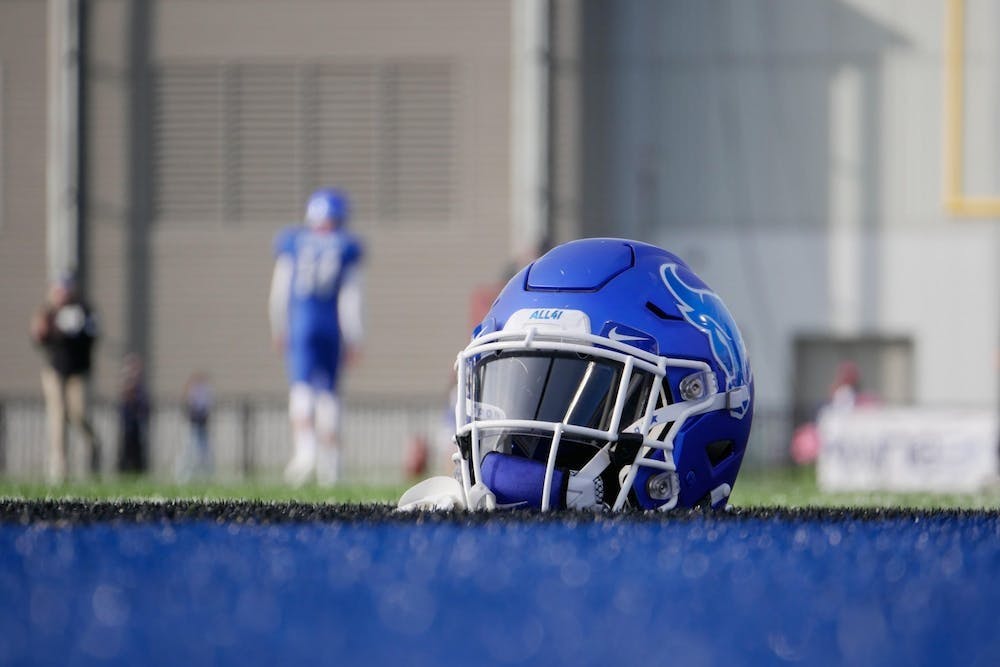One of the biggest challenges about treating a concussion is that they can’t be seen — even on MRI and CAT scans.
“A concussion is an invisible injury,” said Dr. John Leddy, a concussions expert who runs the Concussion Management Clinic at UB.
Symptoms such as headaches, dizziness, trouble thinking and concentrating often go unreported to trainers and coaches.
This is where UB’s Sports Medicine Department comes in. Their job is to educate athletes on the signs of concussions.
At the beginning of every fall semester, the Sports Medicine Department discusses injuries and concussions with each UB Athletics team, according to Dr. Brian Bratta, UB’s athletic director of sports medicine and wellness services. They review symptoms, reporting procedures, return-to-play protocol and the concussion diagnosis process.
“If we can educate them and show them that we’re here to help them and do those things, that makes them a little more trusting and a little more honest with us about signs and symptoms,” Bratta said. “I think that’s made a difference. I think a lot of it is just education.”
UB’s concussion experts hope that their efforts will help mitigate the worst effects of concussions on student athletes.
Continuing to play while concussed doubles one’s recovery time, according to Leddy. If a person hits their head again while concussed, it “more than quadruples recovery time.”
“Imagine if you had the flu for more than a month — that would interfere with your life,” Leddy said.
Along with educating athletes, Leddy also works on enhancing concussion treatment.
He says that 20 years ago, concussions used to be treated as minor injuries. Experts would recommend concussed individuals relax in a dark room. But now, with growing research, that’s no longer the case.
While working as a team physician, Leddy realized that telling athletes to hold off on exercising wasn’t helping. So he and his research partner of 20 years, Dr. Barry Willer, decided to try a new approach: light aerobic exercise.
They started treating concussion patients with a treadmill test adapted from a treatment plan for heart disease. They first started with patients who had symptoms for more than a month. The patients walked at a set speed and incline, while their heart rate was monitored, until their symptoms flared up. Eventually, they tested patients closer to when the concussion occurred. Patients recovered faster when they started doing light aerobic exercise — such as walking — within the first few days after a concussion.
“What was nice in this study is we showed that if you did it early in that first week you prevented half of those students from going out to this delayed recovery beyond a month,” Leddy said.
In the wake of concussion-related scandals in the NFL, many have debated the safety of sports like football and questioned whether leagues like the NFL are doing enough to treat concussions. Leddy says he thinks concussion protocols in the NCAA and the NFL are good — they just need to be enforced.
Research on chronic traumatic encephalopathy (CTE) is at the case series stage, “the lowest form of scientific evidence,” according to Leddy.
He also mentioned that, to his knowledge, occasional concussions from playing sports in high school or college is unlikely to lead to negative long term effects. He added that it’s repeated impacts to the head over many years that tend to increase risk of developing CTE.
But adolescents suffer the most from concussions in terms of what it does for their daily life, especially because they have a longer recovery time than adults.
“Nobody’s quite sure why that is,” Leddy said. “I’m sure it has to do with brain development and blood flow and hormones.”
Concussions take students out of sports and school, which can cause student athletes to feel depressed, especially if their symptoms are prolonged.
Everyone heals differently and everyone’s body is different, which means that some people can heal in days, while for others it can take months. There are many factors that go into this, according to Bratta and Leddy, including age, pre-existing conditions and previous concussions.
When treating student athletes, there is a “return-to-play protocol,” which includes limited activity, followed by light aerobic activity, sport specific exercises without head involvement, practicing but without contact, unrestricted training and finally a full return to sport.
There is also a “return-to-learn protocol” for students who have trouble sitting in class or taking tests with concussion symptoms. This involves an individual plan with doctors and academic advisors.
“The brain heals at its own pace, but we want to make sure that the brain heals the way it’s supposed to so that they can still be a student and still have a life,” Bratta said.
With new research, protocols, treatment and education, concussions — while serious — aren’t always as scary as they seemed in the past.
“The general public should know that a concussion is an injury to the brain that has to be respected,” Leddy said. “But if you see someone early enough and get the right approach, you can actually improve recovery and you don’t have to wait around until all your symptoms just go away.”
Amy Maslin is a sports editor and can be reached at amy.maslin@ubspectrum.com





